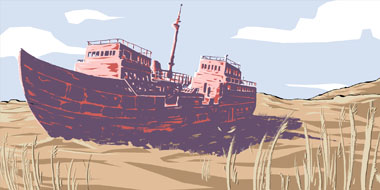Overview of Grade 5 Curriculum
Keeping Track of Matter
Public Domain, via Wikimedia Commons

We expect puddles to dry up after the rain stops. We are not surprised when drops of water collect on the glass holding our cold drink. However, we never get to see the water that has evaporated from the puddle or see the drops before they appear on the glass. What makes these phenomena possible? They can be explained by one of the most significant realizations in the history of science: that water and all matter is composed of unimaginably large numbers of extremely tiny particles (atoms or molecules). Scientists use the phrase the particulate nature of matter to describe this understanding of the composition of matter. Too small to see individually, each of these particles has just a tiny bit of weight and takes up just a tiny bit of space. When countless trillions of particles clump together, they can make an object feel pretty heavy.
Particles exist in a constant tension between the chemical bonds, which tend to hold them together, and heat energy, which keeps them in constant motion and tends to cause them break loose from one another. When water particles leave the surface of a puddle or other body of water, via evaporation, it’s because of this heat-related energy and motion. These particles maintain their identity as water particles after they have evaporated, but are in the form of a gas we call water vapor.
Without using the terms molecules or atoms, this curriculum unit provides students with a set of experiences that helps them develop the understanding that particles too small to see can have weight, take up space, and can help us understand the story behind transformations such as puddles evaporating or drops condensing on a glass.
In Section 1, Water, a liquid, students are introduced to the mystery of a disappearing sea and the scale at which evaporation can occur. They build their own mini-lakes, and review concepts of weight, volume, and heaviness for size (the term we use in place of density). As students investigate salt dissolving in water they are introduced to three concepts that are central to the goals of this curriculum: 1) the matter we encounter in everyday life at the visible level is composed of tiny particles that are visible only when they are clumped together, and become invisible when they spread apart; 2) these individual particles continue to have weight and take up space even when they are spread apart and are too small to see; and 3) these particles must exist in unimaginably large numbers in order to account for the measurable size and weight of objects in the macroscopic world.
In Section 2, Water to Vapor, evaporation and condensation are investigated. Students consider, "What happens to water when it evaporates? Does evaporation destroy water, or does water continue to exist after it evaporates?" As students explore evaporation within a closed system, they also start to see the relationship between condensation and temperature.
In Section 3, Water to Ice, students consider how ice and water compare. While at the visible scale most of the properties of ice and water are quite different, the individual particles are identical. Students cannot prove this, but they rely on a combination of data they have collected, scientific reasoning, and finally a computer model as they consider whether or not water and ice are the same material. Students are presented with the scientists’ belief that all matter - not just salt or water - is composed of tiny particles too small to see individually. The computer model provides the particle view of the solid-to-liquid transformation of water as well as the relationship between temperature and particle motion.
In Section 4, Air, a Gas, students investigate air, a mixture of gases. The class collects data to establish that air has weight, takes up space, and has properties that can be explored and described. Air has much in common with the more tangible forms of matter - solids and liquids - but this form of matter is not visible. Students use the computer model, to investigate the liquid-to-gas transformation of water at the particle level.
In Section 5, Two Scales, students draw the connections between transformations at the visible level and their growing understandings of matter at the particle level. They apply their new understandings to their experiences with their mini-lakes and with bodies of water in the real world.




